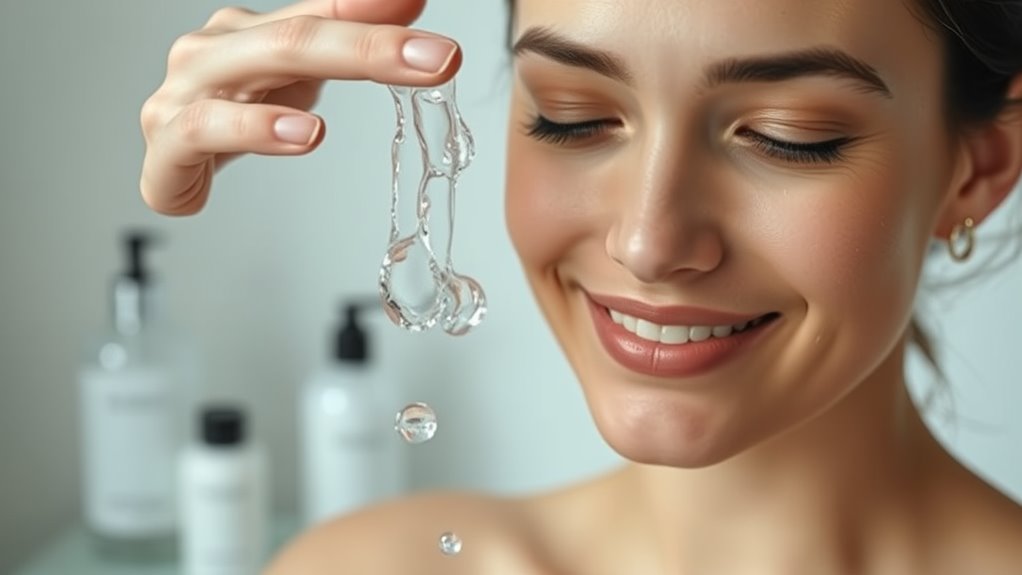Tips for Managing Oily vs. Dry Skin the Right Way
To manage oily and dry skin effectively, you need tailored approaches. Use lightweight, oil-free products for oily skin and rich, nourishing creams for dry skin. Cleansing is key: oily skin benefits from gentle foaming cleansers, while dry skin needs hydrating options. Always follow up with the right moisturizer and consider your lifestyle choices—stay hydrated, get enough sleep, and manage stress. For more insights on balancing your skincare routine, there’s plenty more to explore.
Key Takeaways
- For oily skin, use a gentle, foaming cleanser with salicylic acid and cleanse twice daily to control excess oil.
- Opt for hydrating cream cleansers for dry skin to retain natural oils and follow with a nourishing moisturizer.
- Choose lightweight, oil-free moisturizers for oily skin, while dry skin benefits from rich creams or ointments with humectants.
- Maintain hydration by drinking plenty of water and practicing stress management techniques to promote overall skin health.
- Regular exercise and adequate sleep (7-9 hours) enhance circulation and skin repair, contributing to a radiant complexion.
Understanding Oily and Dry Skin Types
When you understand your skin type, it becomes easier to manage its unique needs. Oily skin often feels greasy and may have enlarged pores, leading to breakouts. It’s essential to maintain skin balance by using lightweight, oil-free products that control excess sebum without stripping moisture.
On the other hand, dry skin can feel tight and flaky, indicating a lack of hydration. For this type, focus on nourishing creams that restore moisture and bolster your skin’s protective barrier. Incorporating proper cleansing techniques can also play a crucial role in maintaining optimal skin health.
Recognizing these characteristics allows you to tailor your routine effectively. Mastering your skin type’s requirements not only enhances your appearance but also promotes lasting skin health. Embrace this knowledge to achieve ideal skin balance and confidence in your everyday routine.
Importance of Cleansing for Different Skin Types
Cleansing is essential for maintaining healthy skin, but the right technique varies based on your skin type.
If you have oily skin, you’ll benefit from methods that control excess oil, while those with dry skin should focus on hydrating cleansers.
Understanding these differences can make a big impact on your skincare routine.
Cleansing Techniques for Oily Skin
If you have oily skin, effective cleansing is essential for maintaining a balanced complexion. Start with a gentle, foaming cleanser that targets excess oil without stripping your skin. Aim for a pH-balanced formula containing salicylic acid or tea tree oil; these ingredients help unclog pores and reduce breakouts.
Cleanse twice daily—once in the morning and once before bed—to remove dirt and impurities. Use lukewarm water to avoid irritation, and always follow up with a lightweight, oil-free moisturizer to maintain hydration.
Don’t forget to exfoliate 1-2 times a week with a chemical exfoliant to slough off dead skin cells and prevent buildup. Mastering these techniques will keep your oily skin looking fresh, clear, and healthy.
Cleansing Methods for Dry Skin
For those with dry skin, the approach to cleansing takes a different angle. You need to focus on retaining moisture while effectively removing impurities. Opt for gentle, hydrating cleansers that won’t strip your skin’s natural oils.
Here’s a quick reference table to guide your cleansing routine:
| Cleansing Method | Benefits |
|---|---|
| Cream Cleanser | Nourishes and hydrates skin |
| Micellar Water | Gentle and soothing |
| Oil-Based Cleanser | Dissolves makeup without drying |
Incorporating these methods will help maintain your skin’s barrier, allowing it to remain supple and healthy. Always follow cleansing with a nourishing moisturizer to lock in hydration. Mastering your cleansing routine is key to vibrant, well-hydrated skin.
Choosing the Right Moisturizer
How do you choose the right moisturizer for your skin type? Selecting the perfect moisturizer requires understanding your skin’s unique needs. Here’s a guide to help you decide:
-
For Oily Skin****: Look for lightweight, oil-free gels or lotions that hydrate without adding excess oil.
-
For Dry Skin****: Opt for rich creams or ointments containing humectants like glycerin and hyaluronic acid to lock in moisture.
-
Combination Skin: Choose a balanced moisturizer that offers hydration without overwhelming oily areas.
-
Sensitive Skin: Select fragrance-free, hypoallergenic formulas to avoid irritation and inflammation.
Understanding your skin type is crucial, as different skin types react uniquely to various ingredients, impacting the effectiveness of your moisturizer.
Tailoring Your Skincare Routine
While everyone’s skin is unique, tailoring your skincare routine to match your specific needs can make a significant difference in its health and appearance.
Start by evaluating your skin type—oily, dry, or combination. This foundational step helps you select products that work harmoniously with your skin’s natural balance.
For instance, if you have oily skin, focus on lightweight, non-comedogenic formulations. Conversely, if your skin is dry, prioritize richer, hydrating ingredients.
Make sure you include a gentle cleanser, an effective exfoliant, and a suitable moisturizer. Incorporating dermatologist-approved routines can further enhance your skincare effectiveness.
Don’t forget to adapt your routine seasonally; your skin’s needs may change with weather fluctuations.
Treatment Options for Oily Skin
To achieve a balanced complexion, consider incorporating the following strategies into your routine:
-
Salicylic Acid: Use a cleanser with salicylic acid to penetrate pores and reduce excess oil.
-
Clay Masks: Apply clay masks weekly to absorb oil and detoxify your skin.
-
Oil-Free Moisturizers: Opt for lightweight, oil-free moisturizers to hydrate without adding shine.
-
Exfoliation: Exfoliate regularly with gentle scrubs or chemical exfoliants to slough off dead skin cells and prevent clogged pores.
Additionally, be mindful of hidden habits that may worsen your acne, such as touching your face frequently or using dirty makeup brushes.
Treatment Options for Dry Skin
Managing dry skin requires a different approach than dealing with excess oil. To effectively treat dry skin, start by using a gentle, hydrating cleanser that won’t strip your skin of its natural moisture.
After cleansing, apply a rich moisturizer containing ingredients like hyaluronic acid, glycerin, or ceramides to lock in hydration. Don’t forget to exfoliate regularly, but opt for mild exfoliants to avoid irritation.
Incorporating occlusives like petrolatum or shea butter can further seal in moisture. Additionally, consider using a humidifier in your living space, especially during dry seasons. Calming ingredients such as aloe vera or chamomile can also help soothe and reduce inflammation in dry skin.
Finally, remember to protect your skin from harsh weather and UV rays by applying a broad-spectrum sunscreen daily. These steps will help restore your skin’s barrier and enhance its overall health.
Dietary Considerations for Skin Health
To maintain healthy skin, it’s essential to contemplate how your diet impacts its condition. A balanced intake of nutrients can greatly enhance your skin’s appearance.
Here are four dietary considerations to keep in mind:
-
Omega-3 Fatty Acids: Include fatty fish, walnuts, and flaxseeds to reduce inflammation and keep skin hydrated.
-
Antioxidant-Rich Foods: Consume berries, dark chocolate, and leafy greens to protect your skin from oxidative stress.
-
Hydration: Drink plenty of water and eat water-rich fruits like cucumbers and oranges to maintain skin elasticity.
-
Limit Sugar and Processed Foods****: Reducing these can help prevent breakouts and promote a clearer complexion.
Lifestyle Tips for Balanced Skin
While your diet plays an essential role in skin health, your lifestyle choices can greatly impact how balanced your skin feels and looks.
Prioritize hydration by drinking plenty of water throughout the day; this helps maintain skin elasticity and moisture. Regular exercise boosts circulation, delivering oxygen and nutrients to your skin cells, promoting a radiant complexion.
Get sufficient sleep—aim for 7-9 hours—to allow your skin to repair itself. Manage stress through mindfulness techniques or hobbies; stress can provoke skin issues.
Finally, avoid smoking and limit alcohol consumption, as these habits can exacerbate skin problems.
Frequently Asked Questions
Can Skin Types Change Over Time With Age?
Yes, your skin type can change over time due to factors like hormonal shifts, lifestyle changes, and environmental influences. As you age, it’s important to adapt your skincare routine to meet your skin’s evolving needs.
Are There Specific Ingredients to Avoid for Oily Skin?
For oily skin, avoid heavy oils, alcohol, and comedogenic ingredients. These can clog pores and exacerbate oiliness. Instead, focus on lightweight, non-comedogenic products that balance your skin and maintain its natural moisture.
How Often Should I Exfoliate Each Skin Type?
You should exfoliate oily skin two to three times a week to maintain clarity, while dry skin benefits from gentle exfoliation once a week to avoid irritation. Adjust frequency based on your skin’s response and needs.
Can Hormonal Changes Affect My Skin Type?
Absolutely, hormonal changes can greatly impact your skin type. As your hormones fluctuate, you might notice increased oiliness or dryness, so it’s essential to adjust your skincare routine accordingly to maintain balance and health.
Is It Safe to Use the Same Products for Both Skin Types?
It’s not ideal to use the same products for both skin types. You’ll need to choose formulas tailored to each type’s needs, ensuring you effectively address their unique concerns and achieve superior results.





